Posted by Powee Celdran
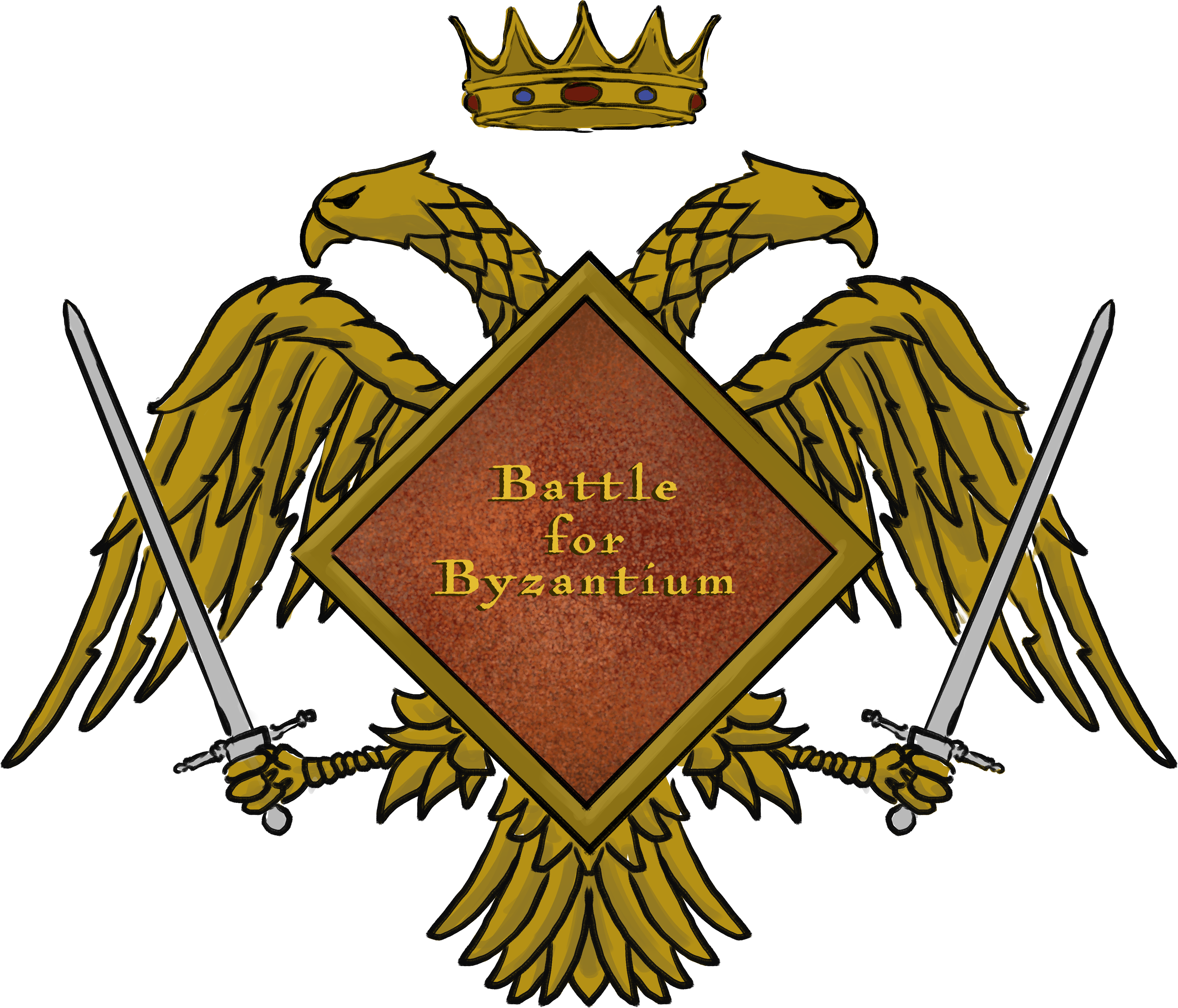
Got to byzantinetimetraveller.com if you’re interested n ordering the game.
As the board game I created Battle for Byzantium is now finally out, here’s another article I made that I would like to share with you all about the game! In the past few months leading up to the game’s release, I wrote 3 articles about the board game: first about how I came up with its idea and what to expect from it, the next being a tour of the 18 cities that feature in the game set in 1025 Byzantium, and lastly about the game’s 4 characters and their background stories. Now that the game has finally been produced and launched, I will write an article about the game’s design elements and more importantly about its mechanics. Now, this game being a 2-4-player action/ conquest game like all games definitely has a set of rules to be followed, though the rules aren’t really complicated but rather quite easy to understand for a war game. In this game, the objective is basically to capture cities wherein there are 18 in the map which features the Byzantine Empire in the year 1025, and at the end the player who owns the most number of cities wins the game. However, the game also features a number of obstacles wherein players can retreat, be in exile due to plague, and even lose a city due to rebellion. This article will now explain how the game is played including how cities can be gained and lost and what obstacles and advantages it has. The game now basically features an alternate historical timeline wherein it is the year 1025 and thus the powerful and popular yet feared Byzantine emperor Basil II (r. 976-1025) has died- which happened in real history- and due to his death, 4 powerful warriors from different backgrounds and civilizations- being Demetrios the Byzantine commander, Al-Sadin the Arab general, Jean-Pierre the Norman knight, and Freydis the Varangian warrior- all compete for control of the Byzantine Empire, though only one can emerge victorious, and this one is the player who conquers the most cities on the map.

Follow me, the Byzantium Blogger on Social Media:
Instagram: @byzantine_time_traveller
Facebook: Byzantine Time Traveller by Powee Celdran
Youtube: No Budget Films
Deviantart: Byzantium-blogger55
Art Station: Powee Celdran Porphyrogennetos
Patreon: Byzantine Time Traveller
Website: byzantinetimetraveller.com

Now with the board game Battle for Byzantium being set in the year 1025, not only the characters and their appearances and background stories but the design elements for the game’s action cards, city cards, and map had to match its historical time setting. As the creator of the game, I conceptualized the map, as well as the action cards and their functions, though the illustrations on the 7 different action cards were done by the game’s lead artist Chrysa Sakel (follow her on Instagram @chrysasakel) while the map and its elements were illustrated by artist Alessia Valastro (follow her on Instagram @alessiahv).
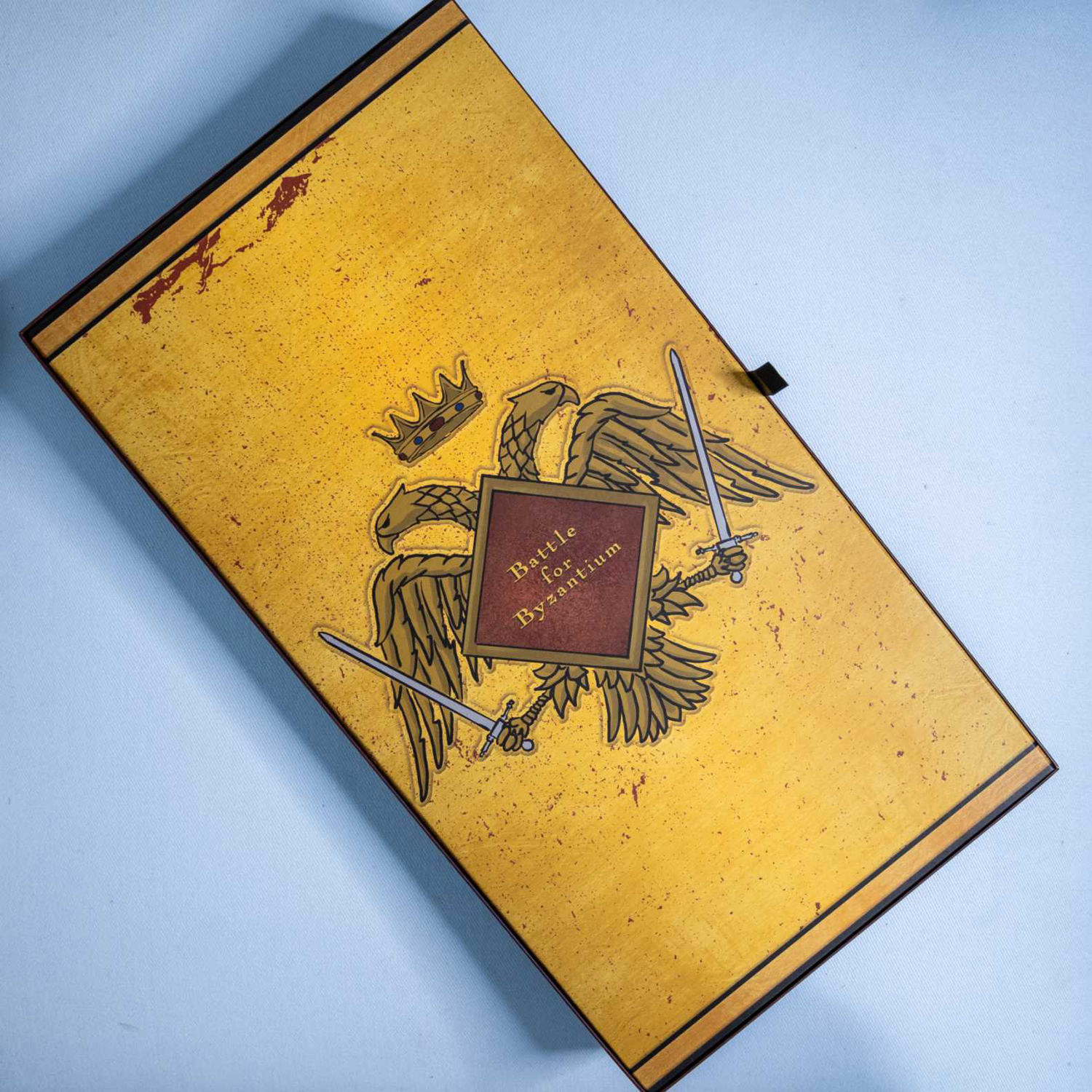
As for Chrysa when illustrating the game’s action cards, it is actually not very far from the main work that she does being the illustrator of the Byzantine Tales comics (follow on Instagram @byzantine_tales) as the period of her comics is actually close to the game’s setting, therefore there is a lot of similarities between the illustrations she made for this game and her comics, especially since this game features many Byzantine Easter eggs such as Greek Fire, weapons, and ornaments. As for Alessia when illustrating the map, she also included Byzantine Easter eggs on it as well such as the golden tiles which represent the tesserae used for Byzantine mosaics and the red tiles which represent the precious porphyry marble used in many Byzantine era structures. Additionally, Alessia says that when illustrating the game’s map and its elements, she made her style match that of Chrysa’s in order to make the finished product consistent despite two artists working on it. Now, as for my part as the game’s creator, ever since I first conceptualized the game back in 2019, I already envisioned the same mechanics it has now, although along the way before the game was fully completed and released, a lot of changes were added to the game’s mechanics as well as to its design elements as the game was being tested a number of times. Additionally, the one person who played a vital role in coming up with a number of the designs for the game’s action cards as well as for the elements on the map was Nilay Tokaoglu (follow her on Instagram @ntokaoglu) who was the game’s creative consultant, and at the end her choices for design elements made it to the final product. And now before beginning the article itself, I would like to give a brief summary of it wherein we will start with a quick intro to the game’s 1025 setting before we move on to the design elements wherein we will first discuss the elements on the map done by Alessia, then the action cards illustrated by Chrysa and their functions, some additional mechanics and features of the game, how to conquer cities and the use of the conquest tokens, and lastly about how to finish and win the game. We too will go over a few behind-the-scenes and the historical significance for some of the action cards and elements in the game, then we will end discussing about how the game’s reception is so far by the public and a wrap-up on the creation process of the game itself. Now, to get to know about the game’s characters and their special abilities please read the previous article, and to get to know how to play the game thoroughly please watch the video below.
The Historical Background on Battle for Byzantium

The board game Battle for Byzantium is set in the year 1025 following the death of the great Byzantine emperor Basil II (r. 976-1025) of the Macedonian Dynasty, and here the Byzantine Empire is the military and cultural superpower of the Middle Ages wherein its borders extend west to east from Italy to Armenia and north to south from the Crimea to Syria.

In his long reign as emperor, the brave though ruthless emperor Basil II expanded Byzantium’s borders through wars of conquest in the north by totally crushing and annexing the Bulgarian Empire into the Byzantine Empire in 1018, in the east annexing parts of Armenia and Georgia, and in the south securing a number of victories against the Arabs. By the time of Basil’s sudden death in 1025 at the age of 67, the Byzantine Empire had seen its borders stretch larger than ever, something the Byzantines (Romans) never saw their empire at ever since the glory days of the 6th century under Emperor Justinian I the Great (r. 527-565)- though back then the Byzantine (Eastern Roman) Empire almost controlled the entire Mediterranean. At Basil II’s death however, the Byzantine Empire was practically still a superpower compared to almost all other medieval powers in Europe and the Middle East that true enough other powerful states such as the Holy Roman Empire and the Kievan Rus’ Empire either were in fear of Byzantium or respected its power and culture while other neighboring kingdoms to Byzantium more or less feared its military power that they did not want to mess around with Byzantium or else suffer the same fate as Bulgaria in being totally wiped off the map as it has been annexed into Byzantium. However, no matter how great Basil II was as a warrior, diplomat, and statesman emperor who had left behind a powerful empire not just militarily but in terms of state administration and diplomacy, his major problem was succession as Basil true enough never married in his whole lifetime and therefore did not produce any children to be his heirs.

Fortunately, Basil had a younger brother Constantine VIII who being his co-emperor for the longest time- ever since both Basil and Constantine were children wherein both were crowned as co-emperors by their father the emperor Romanos II (r. 959-963)- succeeded him as the new emperor. The new emperor Constantine VIII (r. 1025-1028) however was nothing compared to his strong ruling older brother as Constantine did not possess the ability and experience his brother had in ruling an empire, rather he was someone that would turn out to be a weak, useless, and often times a cruel ruler. In real history, we all know that the great and strong emperor Basil II was succeeded by his weak brother Constantine VIII and it was in his short 3-year reign when the glory days of the empire would begin to end and thus the empire would go all downhill from here on. True enough, just immediately after the glory days of Byzantium under Basil II and the Macedonian Dynasty, the Byzantine Empire would experience an age of gradual decline with weak rulers, corruption in the government, and foreign invasions by new powers coming into the scene such as the Seljuk Turks in the east and the Normans in the west. Sad enough, it was all during the same century being the 11th century when Byzantium went from glory days to an age of decline which culminated in Byzantium’s fatal defeat to the Seljuk Turks at the Battle of Manzikert in 1071, and thus after that the empire would never really recover to how it was in 1025.

In this game however being an alternate historical timeline, all these setbacks Byzantium would face following Basil II’s death in 1025 could be reversed if either of the 4 characters- Demetrios, Al-Sadin, Jean-Pierre, and Freydis- seized the empire. Here in the game’s story at least, history is altered following Basil’s death as here these 4 warriors from different lands and of different ethnicities exploit the weakness that the empire is in now that the weak Constantine VIII is the new emperor. These 4 warriors thus do not recognize the new emperor Constantine VIII, and thus they all fight amongst each other for control of the empire. As each warrior comes from a different ethnic background, they have their own starting point from where they launch their rebellion to seize the Byzantine Empire. Now despite all warriors having a common cause being to seize the empire, they are in fact not allied with each other as true enough each have their own objective being to seize the empire by capturing cities for themselves, therefore this whole idea makes the game a competitive one wherein each player must seize cities for themselves.

The Map and its Design Elements

First of all, we shall begin with the most important part of the game being the map as this is where all the action takes place. Now the map itself features the Byzantine Empire with its borders (marked by black lines) in the year 1025 wherein as you can see above, the area covered in it spans west to east from Southern Italy to Armenia and north to south from the Danube River to the heart of the Mediterranean Sea with the islands of Crete and Cyprus.

The map basically covers Greece and most of the Balkans, the Greek islands, almost the entire Asia Minor, a part of the Levant which is basically Syria, a part of the Caucasus being today’s Georgia and Russia in the northeast, the Crimea Peninsula, and the Southern part of the Italian Peninsula with a small portion of Sicily- Messina- being visible; and practically these were all the lands under the rule of the Byzantine emperor back then in 1025. Today, the countries that appear in the game’s map would include Italy, Croatia, Bosnia, Montenegro, Serbia, Kosovo, Romania, Bulgaria, North Macedonia, Albania, Greece, Cyprus, Lebanon, Syria, Turkey, Georgia, Russia, and Ukraine. Additionally, the seas of the Byzantine Empire then can also be seen in the map represented in blue and these include the Mediterranean Sea, Ionian Sea, Adriatic Sea, Aegean Sea, Sea of Marmara, and the Black Sea- though the Marmara and Adriatic Seas aren’t named in the map due to lack of space. The entire map itself and all its elements- except for the faces of the 4 characters in their starting points- was illustrated by Alessia who gave the map an antique looking finish basically to give the game a historical feel.

Now the first thing on the map to be mentioned here is its border which runs across all 4 sides, and the design used on the map’s border is based on the border mosaic design used at the 6th century Basilica of San Vitale in Ravenna, Italy where this particular red border with the design of green and white gems on it can be seen in the mosaics of the emperor Justinian I the Great and his wife the empress Theodora and their respective courts. The border mosaic pattern on the game now bears a lot of similarities with the border mosaic seen in Ravenna while this same pattern can be seen on the edges of all 4 sides of game’s box. Now, when I first conceptualized the game being played on a map, I already envisioned it to have an artistic border that would be based on any kind of Byzantine art, though this particular red mosaic border being the one from Ravenna was suggested both by the game’s creative consultant Nilay and by another person on board being Sophia Tan (follow her on Instagram @sophia_lioness_t) before it was illustrated by Alessia. Additionally, on each of the 4 corners of the map are golden square tiles inspired by the design of golden Byzantine tesserae.
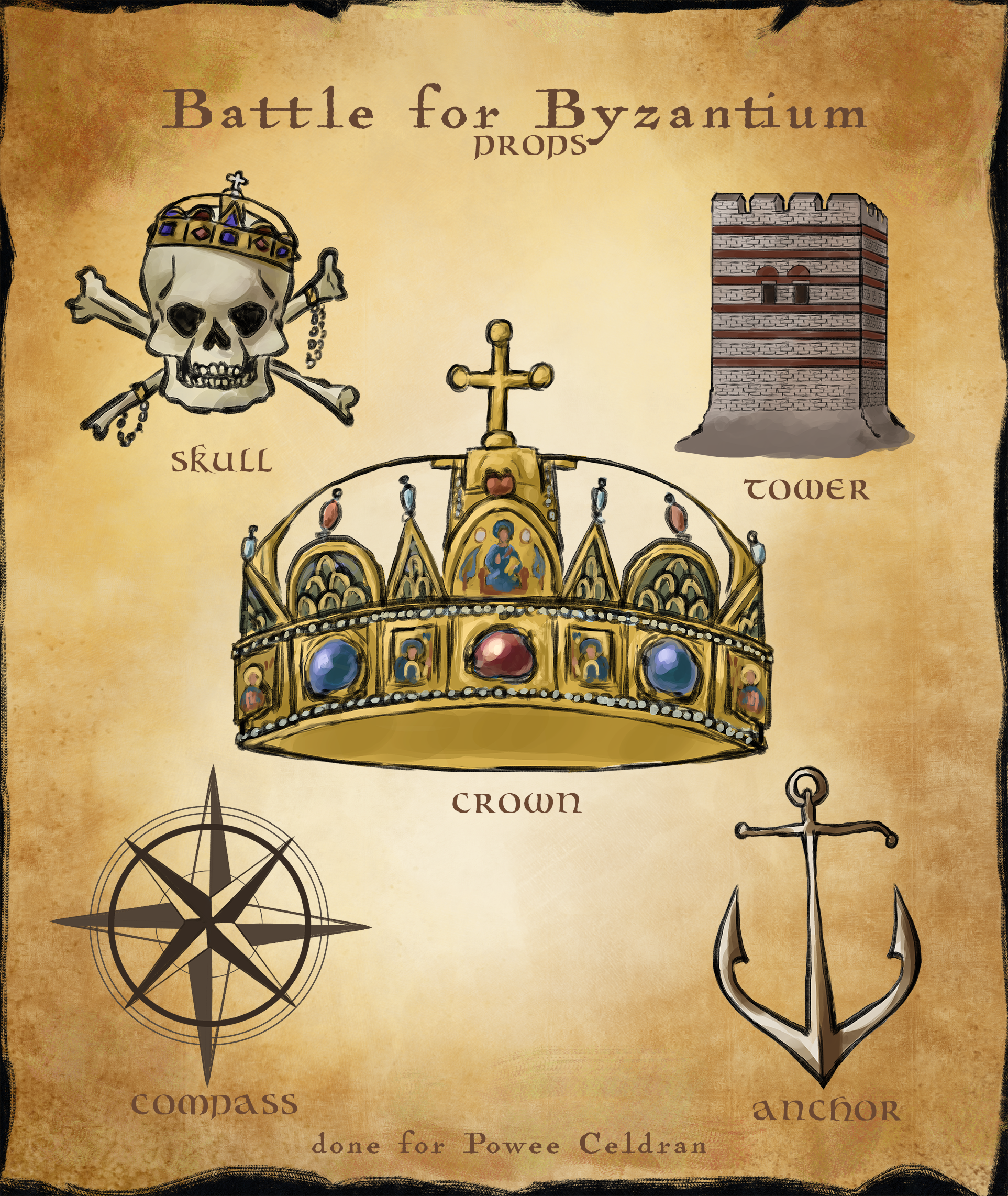

Since the game features 4 playable characters, the map features 4 different starting points wherein each of the characters has their own designated one which has their respective face and color on them. Each of these starting points are located at each edge of the map- north, south, east, west- and come in the form of a rectangular tile and next to it is the name of each character so players know where to place their character when beginning the game.

In the map, Demetrios the Byzantine commander’s starting point is at the east where he is launching his rebellion which was then Mesopotamia which is seen with his face on a rectangular tile with a red background. Al-Sadin the Arab general’s starting point is at the south literally in the middle of the Mediterranean Sea from where he is launching a naval invasion of the Byzantine Empire, and his starting point can be seen with his face on a rectangular tile with a green background. Jean-Pierre the Norman knight’s starting point is at the west being in the region of Calabria in Southern Italy where he is based in and is launching his invasion of the empire, and his starting point can be seen with his face on a rectangular tile with a blue background.

Lastly, Freydis the Varangian warrior’s starting point is at the north being in the Byzantine Empire’s Danube River border where she is based in and is launching her rebellion, and her starting point can be seen with her face on a rectangular tile with a gold background. As a dice game, the map features tiles forming pathways scattered across the map going in all directions like a maze. In this game, players using the dice can choose wherever they want to move across the map wherein the tiles they move across are represented by golden tiles which resemble golden tesserae which are small pieces of colored glass, stone, or ceramic cut in square shapes to create decorative mosaics.
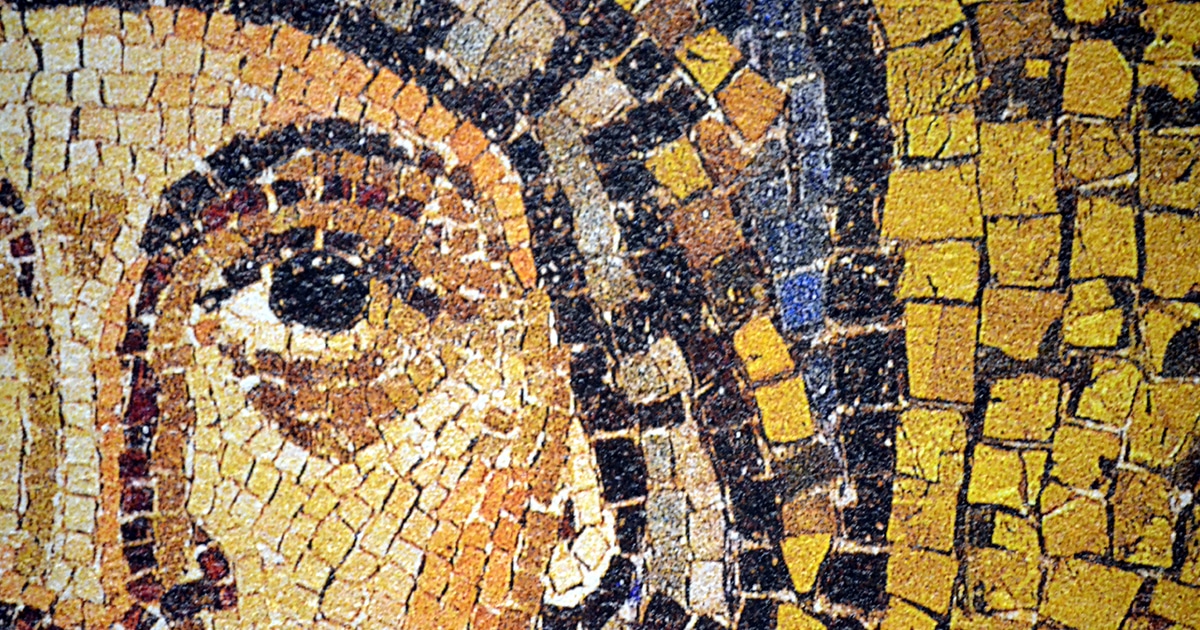
To create these golden mosaics that are found in Byzantium’s greatest churches and palaces, artisans applied thin sheets of gold between two slabs of molten glass cut into small tiles which therefore are tesserae. The map also features a number of larger rectangular red tiles every here and there, and the purpose of these red tiles is that whenever a player’s character lands on it using the roll of the dice, the player must select an action card. The red-purple tiles now that appear on the board represent the precious red-purple marble known as porphyry.

Now, “porphyry” is the Latin word for red-purple and it was the color of nobility for the Romans (and later Byzantines) and this rare kind of stone was quarried in Egypt while its rich purple hue was prized for its rarity and was the preferred material for imperial columns, chambers, churches, and tombs of emperors. True enough in Byzantium, a number of important buildings had columns made of porphyry and most famously the Column of Constantine in the capital Constantinople was also made from it and so are some tombs of Byzantine emperors and even the room in the imperial palace where imperial heirs were born in too was said to have walls made of porphyry. Now when creating the game, I chose for the tiles where players move across to be represented by golden mosaic tiles as a Byzantine Easter egg and so are the porphyry tiles, and to give some special value to porphyry as a precious stone, it was to be the rare tiles where players are to select an action card when landing on it. Before the final designs of the golden tesserae and red porphyry were added to the map, Alessia did a number of samples for them for me and other people behind the game to choose from, and the designs with the most number of votes made it to the finished product.

Aside from the gold tesserae and red porphyry tiles, the game’s map also features 17 castle towers which represent the cities on the map that players are supposed to capture wherein the names of the cities are seen right next to them and these are: Bari, Dyrrhachion, Thessaloniki, Philippopolis, Adrianople, Dorystolon, Cherson, Sinope, Ancyra, Nicaea, Smyrna, Athens, Chandax, Attaleia, Nicosia, Antioch, and Melitene.
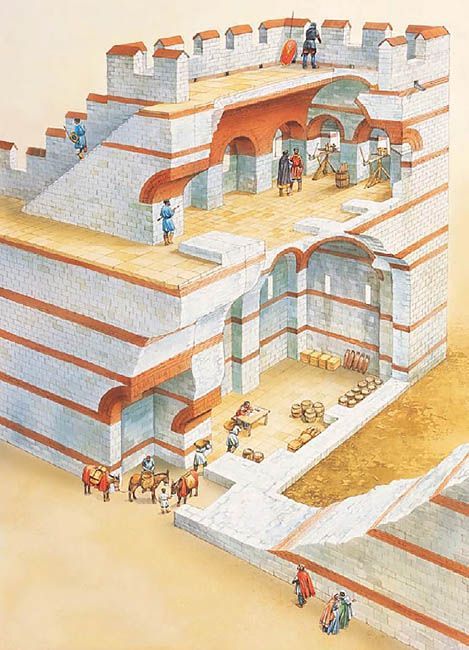
The design of the towers now that represent these 17 cities on the map were based on the appearance of the many towers of Constantinople’s famously impregnable 5th century Theodosian Walls or simply the land walls that withstood constant attacks for over a millennium and was only broken in 1453 by the Ottomans with the use of cannons. As for the design of the towers, Alessia did two samples for them in which I and other people behind the game were to choose from, and again the design with the most number of votes from the people behind the game made it to the finished product. In the meantime, since the game’s map features 18 cities, the imperial capital Constantinople on the other hand is not represented by a tower like the rest but by an imperial crown in order to highlight its importance as the capital. The design of the crown done by Alessia that represents Constantinople on the map now was based on that of the Holy Crown of Hungary also known as the “Crown of St. Stephen” which is one of the two surviving Byzantine crowns today with the other one being the Monomachos Crown also found in Hungary.

The Crown of St. Stephen now despite being used as the coronation crown for Hungarian monarchs from the 12th century up to 1916 was Byzantine made wherein it is presumed to have been made in Constantinople. However, the date of this crown’s origin is debated as some say it was first presented to the King of Hungary Geza I (r. 1074-1077) by the Byzantine emperor Michael VII Doukas (r. 1071-1078), though some say it is even older dating back to the time of King Stephen I of Hungary (r. 1000-1038) who was crowned with it in either 1000 or 1001, which is why it is known as the “Crown of St. Stephen” in honor of him. If it is true that the crown dates back to the time of Stephen I of Hungary, then the design of the crown is more or less historically accurate in the game as the game is true enough set during the same time Stephen I was King of Hungary thus making him a contemporary of Basil II. Now in Byzantium, the kind of style of crown seen in the map was a common design of an imperial crown worn by Byzantine emperors in the 10th and 11th centuries. Meanwhile, all Byzantine emperors since Leo I (r. 457-474) in 457 were crowned by the Patriarch of Constantinople at the Hagia Sophia cathedral in the imperial capital.

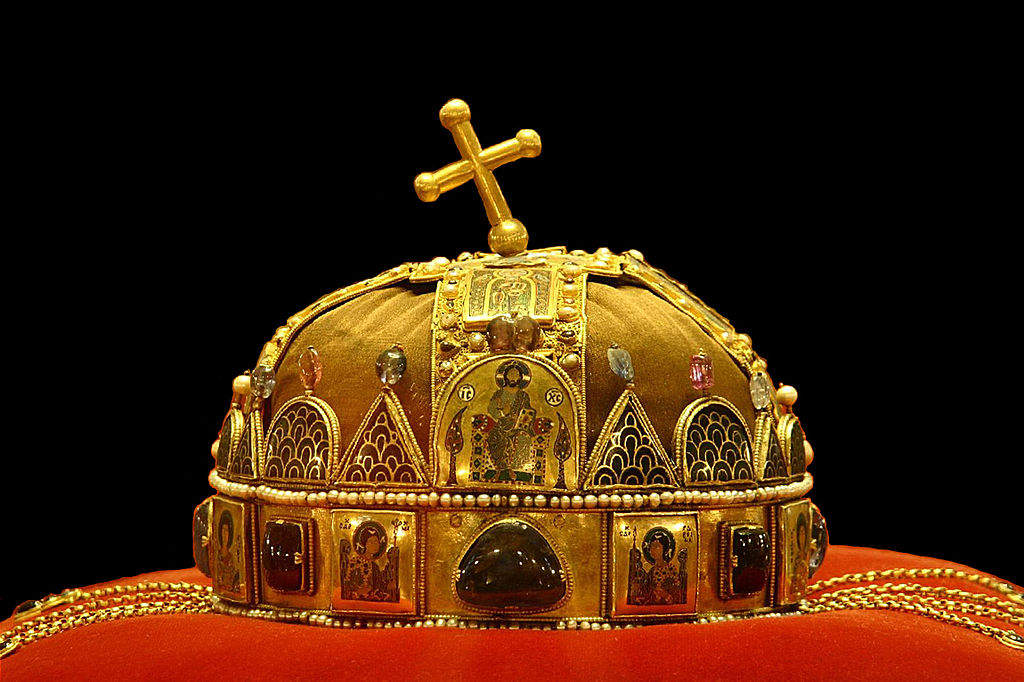
In the meantime, found on the map’s upper-left corner is a skull wearing a Byzantine style imperial crown which was also designed by Alessia.

This skull now represents Ragusa (today’s Dubrovnik, Croatia) and this is where players who get the plague in the game are transported to be exiled and thus lose a turn. Apparently, in medieval history Ragusa had turned out to be a quarantine location for sailors in case they were bringing the plague with them, thus for the game it was very much fitting to have Ragusa in it as a quarantine location for plague victims, and fortunately enough Ragusa was under Byzantine protection in 1025. The skull meanwhile represents the plague which is why the quarantine location Ragusa is represented as a skull, and to add a Byzantine angle to it, Alessia added an imperial crown over the skull. Just like with the towers, porphyry, and golden tesserae tiles, Alessia did a number of samples for the skulls and the sample with the most number of votes from the people behind the game made it to the finished product. On the other hand, found on opposite ends of the map- at the upper-right (Black Sea) and lower-left (Ionian Sea) corners- are the “gain a navy” anchors, and in the game these anchors work when players land on them with the roll of the dice, and when landing on them players can choose to capture any city of their choice. The anchor’s design though was not based on any kind of historical anchor but simply on a generic one, and like with the other elements on the game’s map, Alessia did a number of samples for it and the sample of the anchor again with the most number of votes from the people behind the game made it to the finished product.

Furthermore, on the map’s upper-right corner in the Black Sea right next to the “gain a navy” anchor there is a large compass which was also illustrated by Alessia and just like the anchor it was not based on any historical compass but rather on a generic one, and its purpose is more or less a decoration on the map but to also give players a sense of direction. On the other hand, located above the gold tesserae tile pathway at the upper-left part of the map (being the Balkans) is the game’s title “Battle for Byzantium” also done by Alessia and so is the game’s logo- being a Byzantine style golden double-headed eagle with a crown above- on the lower-left corner of it right next to the Ionian Sea “gain a navy” anchor. Another thing Alessia included in the game’s map are the rivers, lakes, and other bodies of water in that part of the world, though the one thing that was omitted in the map were biomes such as forests, mountains, and deserts as a way to simplify things.
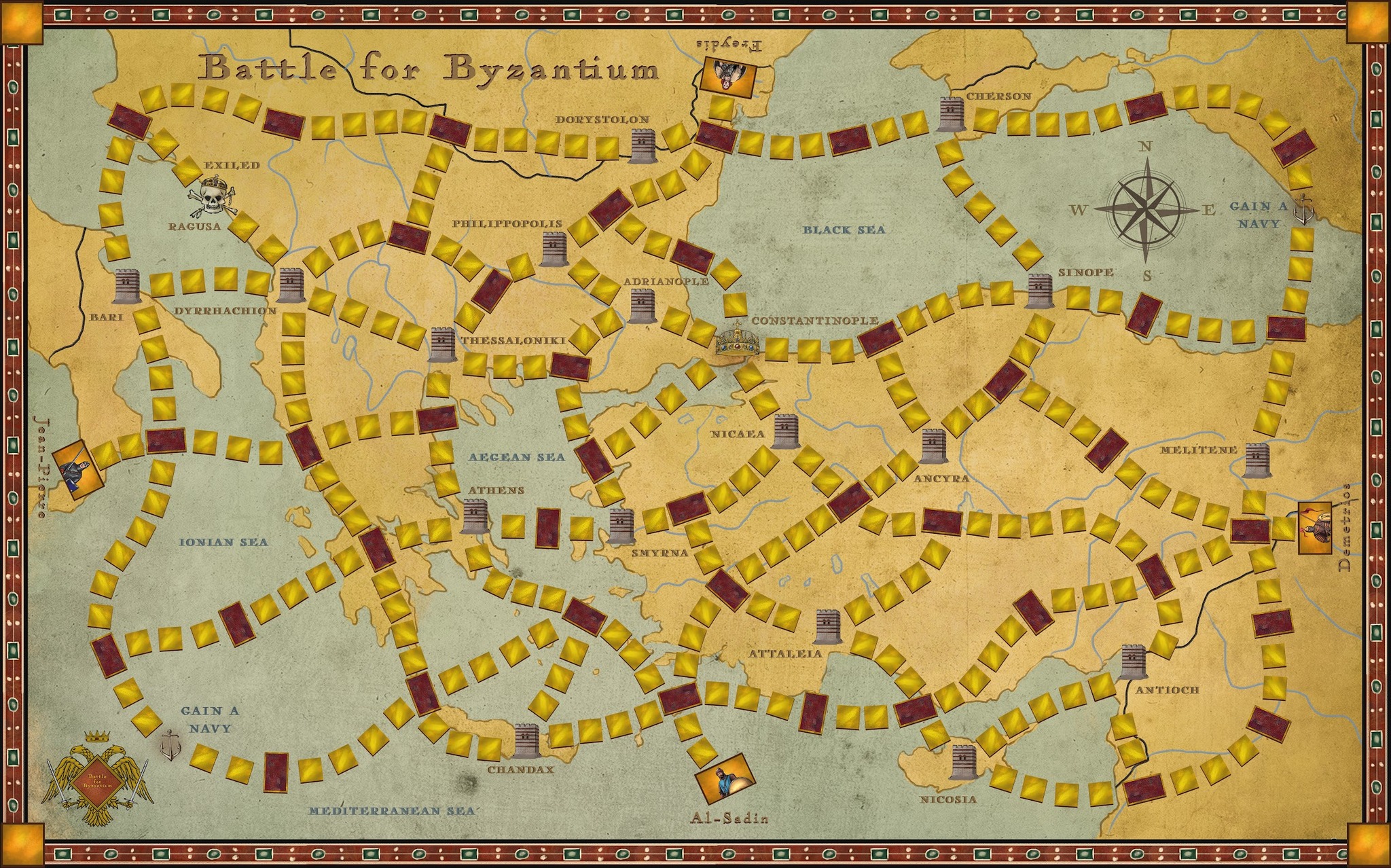
The Action Cards

In the game, there are a total of 50 action cards which have 7 different kinds of functions. Each time a player lands on a red porphyry tile, he or she gets to pick a card. The cards that are picked when a player lands on a porphyry tile are random but again there are only 7 kinds that players can pick. The cards determine the players’ actions. To begin the game, each player must roll the dice and the one who has the highest number starts and thus rolls the dice again to proceed across the tiles.
The “Gain Gold” Card
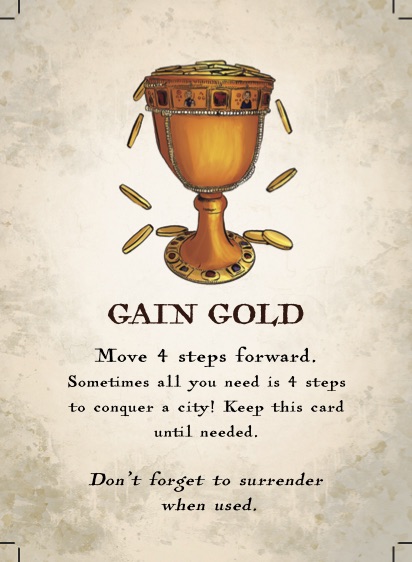
When being selected, this card allows the player to move 4 steps forward. Sometimes all that is needed is 4 steps to conquer a city- if the player has the “gain an army card”- or to land on another porphyry tile. Therefore, this card can be kept when needed in the future just in case a player is 4 steps away to a city or a porphyry tile. When already used, this card must be surrendered to the discard pile.
The “gain gold” card features an image of a golden Byzantine chalice studded with jewels and filled up with gold coins to the point of it spilling out illustrated by Chrysa. This gold chalice seen on the card was inspired by a golden Byzantine chalice decorated with semi-precious stones and enamel plaques featuring saints which dates back to 1070 and is today found at the Treasury of St. Mark’s in Venice, Italy. Now when first conceptualizing the game back in 2019, I already had a “gain gold” card in mind as a kind of card that allows players to advance, however back then I had no design in mind for the card but I already thought of using gold for the card as a Byzantine Easter egg referring to the Byzantines using gold coinage in their history. Originally during the early development phase of the game, this card was supposed to be used as a kind of currency card which players keep and use when they pass another city another player owns; however, this rule was omitted as it was too confusing for players. During the creation process of the game in 2022, the first draft of the “gain gold” card illustrated by Chrysa appeared much simpler featuring only a gold jeweled necklace. However, the game’s creative consultant Nilay suggested the idea that the gain gold card should feature the design of the exact same golden chalice found in Venice, which thus true enough made it to the finished product. Out of all the 50 action cards in the game, there is a total of 12 “gain gold” cards.

The “Gain an Army” Card

When being selected, this card allows a player to capture an open city when landing on one with the roll of the dice, thus this card must be kept until landing on an unconquered city. Take note that this card only works in capturing open cities on the map, therefore if a player owns this card and lands on a city someone owns, it cannot be taken with this card. Once the card is used, it must be immediately surrendered to the discard pile. In order to capture the capital Constantinople, a player will need two of these cards. In the meantime, the special advantage of the game’s character Freydis is that she can use this card twice instead of once which means she can use one “gain an army” card to capture two cities or she can also use this ability once in the game to capture Constantinople with just one “gain an army” card when landing on it with the roll of the dice as this power is equivalent to using two “gain an army” cards. However, this power of hers regarding the “gain an army” card’s use only works once in the game.
The “gain an army” card features an image of a red Byzantine kite-shaped shield with two Byzantine style swords crisscrossing it in front.
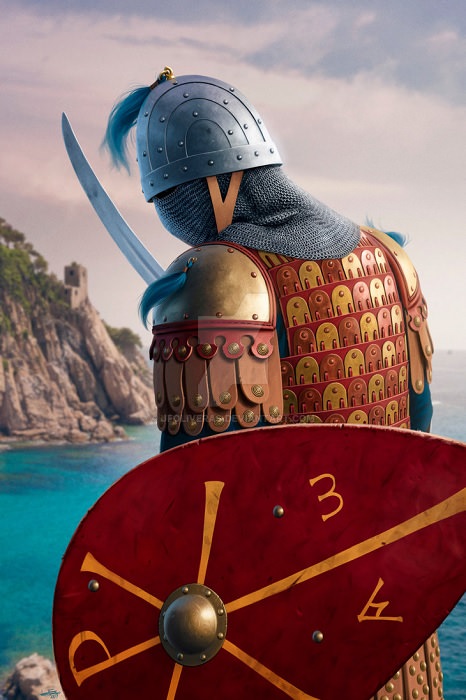
For the image of the swords and shields in this card, Chrysa as its illustrator based them more or less on the illustrations she made of swords and shields in her Byzantine era comics. The design on the red shield now features a yellow cross which turns out to be a common design on Byzantine shields used by Byzantine soldiers especially in the 10th and 11th centuries while its kite shape was a common one used by Byzantine soldiers. Now, when first conceptualizing the game back in 2019, I already had a “gain an army” card in mind as a kind of card that allows a player to capture a city as true enough gaining an army allows someone to seize a city while using the card only to capture a city when landing on it is a reference to marching an army to capture a city which was how armies captured cities back then. During the development phase of the game, I already had a design of two swords and a shield in mind for this card, thus it was this exact design which Chrysa illustrated that made it to the finished product. Out of all the 50 action cards in the game, there is a total of 12 “gain an army” cards.
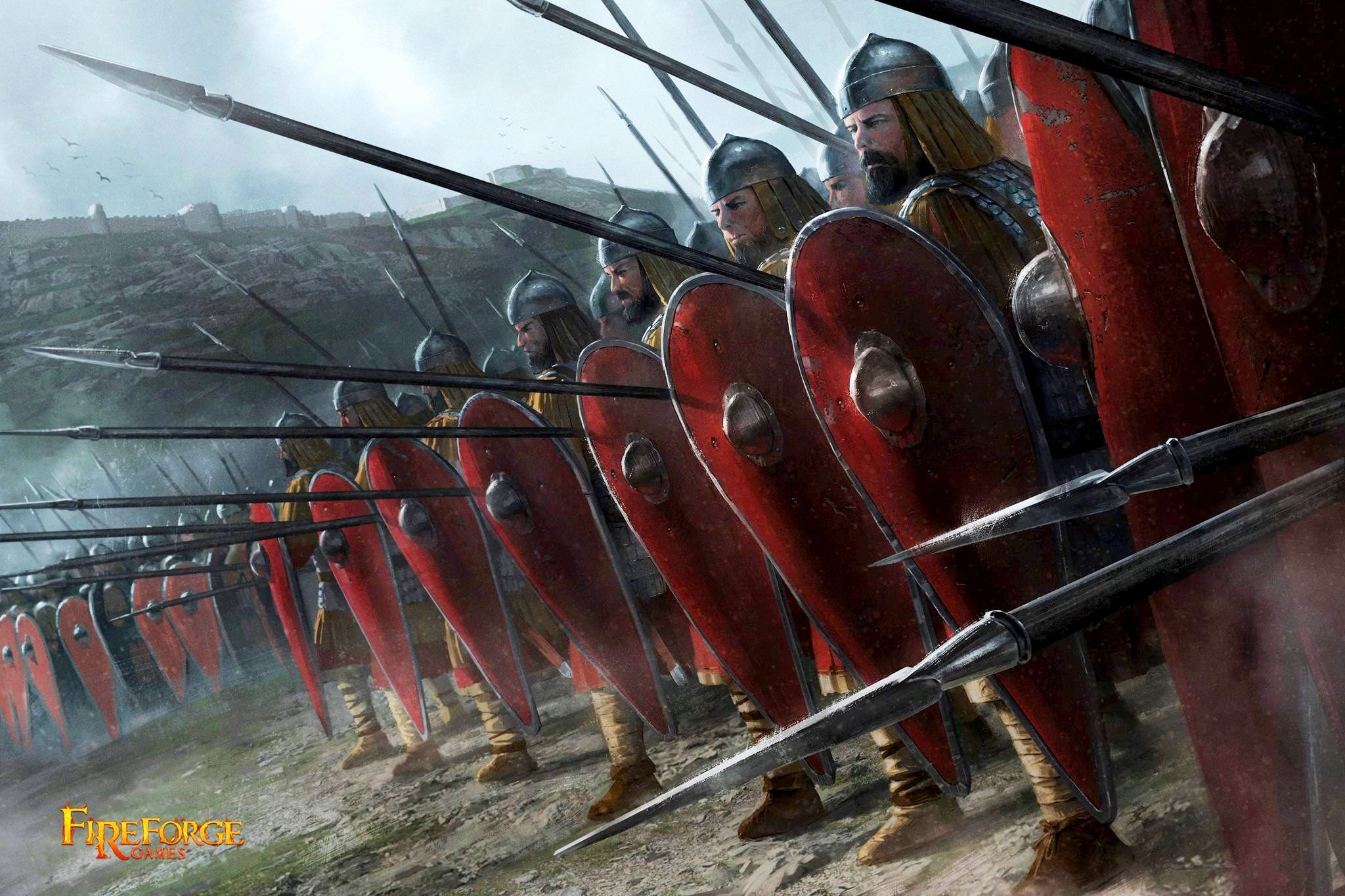
The “Greek Fire” Card

When being selected, this card forces a player to return to his or her starting point on the board, though when returning to his or her starting point with this card, the player does not lose a turn. Once the card is used, it must be immediately surrendered to the discard pile. In the meantime, the special advantage of the game’s character Demetrios is that he is immune to this card only once in the game, meaning he is not forced to return to his starting point at least only once in the game. Additionally, as Demetrios is immune to this card once in the game, he can keep this card in order to capture an open city once in the game similar to the “gain an army” in which this can only be used to conquer an open city and only when landing on it with the roll of the dice.
The “Greek Fire” card features an image of Byzantium’s secret superweapon being Greek Fire represented in the form of a gilded dragon head spewing out liquid fire from its mouth like a flamethrower. True enough, Greek Fire as a weapon emitted from Byzantine ships was usually emitted from a siphon in the form of a dragon’s head, and once emitted the liquid fire had the power to burn down enemy ships and even stick on water for a time, thus the mere sight of the Greek Fire alone emitted from these kinds of siphons on Byzantine ships overpowered their enemies causing some to jump into the water to their deaths out of fear.

For this image of the Greek Fire which includes both the gilded dragon siphon and the liquid fire emitted from it, Chrysa based it on both the illustrations she did of Greek Fire in her comics and on other illustrations of the superweapon Greek Fire used by Byzantine ships. Now, when first conceptualizing the game back in 2019, I already had a “Greek Fire” card in mind as a kind of card that will give players an obstacle while I also thought of adding this card as a reference to Greek Fire as Byzantium’s secret superweapon. True enough in the game’s 11th century setting, as Byzantium was at its height of power as a medieval empire, Greek Fire was its prized superweapon which the Byzantines did not share with anyone its formula as this was basically the weapon that saved the empire many times from foreign invasions. Originally, during the game’s development phase, the “Greek Fire” card’s function was that it forced players to move back by 5 steps as a reference to the power of this weapon which forces enemies to retreat, however for the finished product this particular function was changed wherein this card would instead force players to return to their starting point as a way to show that this weapon is more powerful than just forcing people to retreat by just a few steps. This card though is a rare one in the game as it has a strong effect, and out of all the 50 action cards in the game, there is only a total of 4 “Greek Fire” cards. Originally, there was supposed to be more than 4, but since it has a strong effect on players, it was reduced to 4.

The “Besiege a City” Card

When being selected, this card allows a player to capture the nearest open city to him or her, thus when selecting this card on a porphyry tile, the player automatically captures a city without having to land on it with the roll of the dice. When this card is drawn, a player must immediately relocate his or her character to the nearest open city to him or her, and thus when already used it must be immediately surrendered to the discard pile. This card works on capturing any city on the map represented by a tower except for Constantinople. Just like the “gain an army” card, this card only works when it comes to capturing open cites, thus it does not work when capturing any owned city. If a player selects this card when there is no open city nearby then a player will have to still capture the nearest open city even if it is far away from where the player is.
The “besiege a city” card features an image of a Byzantine or more or less a medieval era siege engine with a sling loaded with a stone about to attack a walled city. The particular look of this siege weapon illustrated by Chrysa bears resemblance to a Byzantine siege weapon seen in the illustrated chronicle known as the Madrid Skylitzes from the 11th century which true enough features illustrations of Byzantine history in the same era the game is set in, so the siege weapon seen in the card should more or less be accurate if it was based on the one seen in the Madrid Skylitzes. The whole idea of this card’s function is a reference to besieging cities as true enough just like how it is in the game where players capture a city from a distance, this is how it works in a siege wherein the besiegers lay siege to a city from a distance. Additionally, the part about the “besiege a city” card not working when it comes to capturing Constantinople is a reference to how no armies were able to successfully besiege Constantinople in its entire history until its fall to the Ottomans in 1453. Now, when first conceptualizing the game back in 2019, I already had a “besiege a city” card in mind as a kind of magic card that allows players to capture the closest open city immediately when selecting it. In the development phase of the game, there was no change added to the use of this card except in adding an illustration to it which in the finished product more or less accurately depicts a Byzantine siege weapon. Out of all the 50 action cards in the game, there is a total of 8 “besiege a city” cards.

The “Plague” Card

When being selected, this card forces a player to be exiled in Ragusa (represented by a skull) at the upper-left corner of the map. When a player gets this card, he or she must immediately relocate his or her character to Ragusa and there the player loses one turn- unlike with the “Greek Fire” card- and thus resumes playing from Ragusa. Once the card is used, it must immediately be surrendered to the discard pile. In the meantime, the special advantage of the game’s character Jean-Pierre is that he is immune to this card only once in the game which means that when selecting it, he does not have to be exiled to Ragusa, and so the card has no use and is thus immediately surrendered.
The “plague” card features an image of death in the form of a skeleton in a black robe holding a scythe which was true enough a symbol of plague. Originally, the plague card illustrated by Chrysa featured a rat as a symbol of plague, however I had her omit that as it could scare potential players, thus for a symbol less provoking but still haunting at the same time, I had Chrysa illustrate death as this is a symbol universally recognized for plague and disease. Now, when first conceptualizing the game back in 2019, I already had a “plague” card in mind as a kind of obstacle card, however back then the map had no Ragusa as an exile place for plague, rather in the old mechanics when players selected it, they would lose a turn staying at the same tile where they selected this card. It was only in the game’s development phase where the whole idea of being transported to Ragusa and losing a turn there when getting this said card came about. On the other hand, I also chose to include a plague card as a reference to the many times plagues struck the Byzantine Empire in its history. Out of all the 50 action cards in the game, there is a total of 6 “plague” cards.

The “Rebellion” Card

When being selected, this card forces a player to lose one city he or she owns. However, if a player selects this card when not yet owning a city, the card thus has no effect and must be immediately surrendered to the discard pile. Once this card is used, it should also be immediately surrendered to the discard pile. In the meantime, the special advantage of the game’s character Al-Sadin is that he is immune to this card only once in the game which means that when selecting it, he does not lose a city he owns, and if the player playing as Al-Sadin selects this card when not owning any city yet, it can be kept for future use.
The “rebellion” card features an image of 3 fists in the air with the central one larger than the other two, and this is a universal symbol of rebellion and uprising. Since there is no creative way of depicting rebellion for a small card, I simply chose to have this universal symbol of rebellion illustrated on the card by Chrysa, and true enough it appears to be as simple as black fists on the air which therefore gives it a strong appearance. Now, when first conceptualizing the game back in 2019, I already had a card in mind similar to the “rebellion” card being the worst card players can get. At first, this was supposed to be the “assassinated” card and then the “blinded” card- the latter being a reference to the practice of blinding political opponents in Byzantium- which had the same function of forcing a player to lose a city. However, both assassination and blinding did not make sense when it comes to losing a city, therefore it became rebellion as true enough this card had turned out to be a reference to a conqueror losing a city he conquered as a result of the conquered people of the city revolting against his or her rule over them. It was in the development phase of the game true enough when the “rebellion” card came about and it true enough made more sense when it came to losing a city someone owns as again it means that the people in any city a player conquered does not like its new conqueror. This card is true enough a reference to the many rebellions in Byzantine history that usually began in cities. Out of all the 50 action cards in the game, there is a total of 6 “rebellion” cards.

The “Sack a City” Card

When being selected, this very rare and powerful card allows a player to steal any conquered city on the map of his or her own choice including Constantinople! When being used, this card must immediately be surrendered to the discard pile. If this card is selected when there is no owned city on the map yet, then it unfortunately has no use and thus must be surrendered to the discard pile. When it comes to capturing the capital Constantinople, then this card can be used on it whether it is owned or not. Unlike the “gain an army” card, players who selects this said “sack a city” card should immediately relocate their character to the city they want to steal from another player, similar to how the “besiege a city” card works.
The “sack a city” card is perhaps the most ornate of the 7 kinds of action cards as this one does not just feature a single image but a number of them which includes a bloody dagger, a treasure chest, coins and jewels, a barrel, and amphorae vases with loot inside. The items seen on this card represent the items taken when a city is pillaged which includes the chest, barrel, and amphorae filled with loot which is mostly gold while the bloody dagger represents the bloody nature of sacking a city. This card contains perhaps the most graphic and mature image in the whole game as it features a dagger with blood spilling out of it all while the name of the card alone is very disturbing and mature especially since sacking a city involves so many unthinkable aspects.

As for the dagger on this card, Chrysa based its appearance on generic medieval daggers all while the other items were just based on generic chests and barrels all while the appearance of the amphorae vases was to give the card a more Roman/ Byzantine look. Now, when first conceptualizing the game back in 2019, I definitely had no 7th card with a kind of superpower in mind, rather the game only began with 6 different kinds of action cards. It was only during the development phase of the game in 2022 when this card was first conceptualized during a game testing session wherein players wanted more excitement wherein conquered cities can be taken, hence the idea for the “sack a city” card was born. True enough, the suggestion for this new card made it to the finished product despite debates about whether to put it or not especially due to the violent nature of sacking a city which may be too disturbing for younger players, but due to the sacking of cities being frequent in the Byzantine era, this card made it to the finished product anyway. The “sack a city” card now is the rarest of the action cards as out of the 50 action cards in the game, there are only TWO “sack a city” cards.

Additional Game Mechanics and How to Win

Aside from the 7 action cards in the game, another part of it that has a function are the two “gain a navy” anchors located on opposite sides of each other- one at the upper-right corner found in the Black Sea coast of Russia and the other at the lower-left corner in the middle of the Ionian Sea. This function only works when players land on either of them by the roll of the dice, and once a player lands on either of them, he or she can take any city of his or her own choosing whether it is already an owned city or not, while players can even choose to capture Constantinople with it. However, the “gain a navy” anchors are very hard to reach and thus players must really go out of the way to get there, but at the end it is very rewarding for players to travel that far to reach them at the most remote corners of the map especially since it allows them to take any city they want. However, each “gain a navy” can only be used once by players, hence if a player has already used both once then he or she cannot use it again. Just like the crown on the map representing Constantinople and the skull representing Ragusa, in the final version of the map, a red porphyry circle was added to both anchors below it in order to make the anchors appear more visible. Meanwhile, when the game was first conceptualized in 2019 I had no “gain a navy” function in mind as back then the game was much simpler and only a draft on an illustration board. It was only in the development phase again when the whole idea of the “gain a navy” came about as players wanted more excitement or other ways to capture a city, hence the magic “gain a navy” function was added to the remote corners of the game map. The “gain a navy” meanwhile is a reference to how commanders in Byzantine history possessed great power to the point of capturing cities and this was by controlling a navy. Logically, using a navy to conquer cities can only work on coastal cities and not on inland ones. However, in order to keep things simple in the game, the “gain a navy” does not just work on coastal but inland cities as well.

Although “Battle for Byzantium” isn’t entirely all a strategy game, there are still some strategies involved that players should keep in mind as well. One strategy here is that players must look closely at the map and choose their own path carefully as here in this game, players can go in any direction they choose. Another strategy players should take note of as well is that they must know when to maximize the special advantage of their character especially since it can only be used once in the game, thus it must be used when it is most advantageous. Lastly, players who seem to be winning should also look at the map carefully and should try their best to avoid landing on the red porphyry tiles especially if it would mean drawing a “rebellion” card which would thus make the player lose a city they worked so hard to gain. True enough, in this game players may think they may be winning by possessing so many cities, but fortunes can turn quickly and thus the one who seems to be winning may still not win at the end.

Meanwhile, in the game players are given a color-coded handmade pouch which contains 18 wooden tokens each- due to there being 18 cities on the map- and these tokens have the respective color of the character and the first letter of the character’s name on it in the form of a sticker. Here, those who play as Demetrios are given a red pouch with 18 red tokens bearing a “D” which is the first letter of his name, those who play as Al-Sadin are given a green pouch with 18 green tokens bearing an “A”, those who play as Jean-Pierre are given a blue pouch with 18 blue tokens bearing a “J”, and those who play as Freydis are given a gold pouch with 18 gold tokens bearing an “F”. These tokens are meant to signify ownership of a city and so when a player conquers a city, he or she must place their character’s respective token on them as a visible sign of ownership. Additionally, the game comes with city cards wherein each of the 18 cities has its own respective card depicting a famous landmark it has illustrated by Chrysa on the front side and behind it some historical trivia on the city and what it is today. 17 of the city cards are colored in sepia and only Constantinople is colored to highlight it as the imperial capital. The conquest tokens and city cards however were not part of the original concept of the game back in 2019 and thus it was only in its development phase in 2022 when the conquest tokens and city cards were included in order to make the game more visual and exciting. Due to the rare case wherein one player may take all 18 cities at the end, it was decided that each player’s pouch should contain a total of 18 conquest tokens.
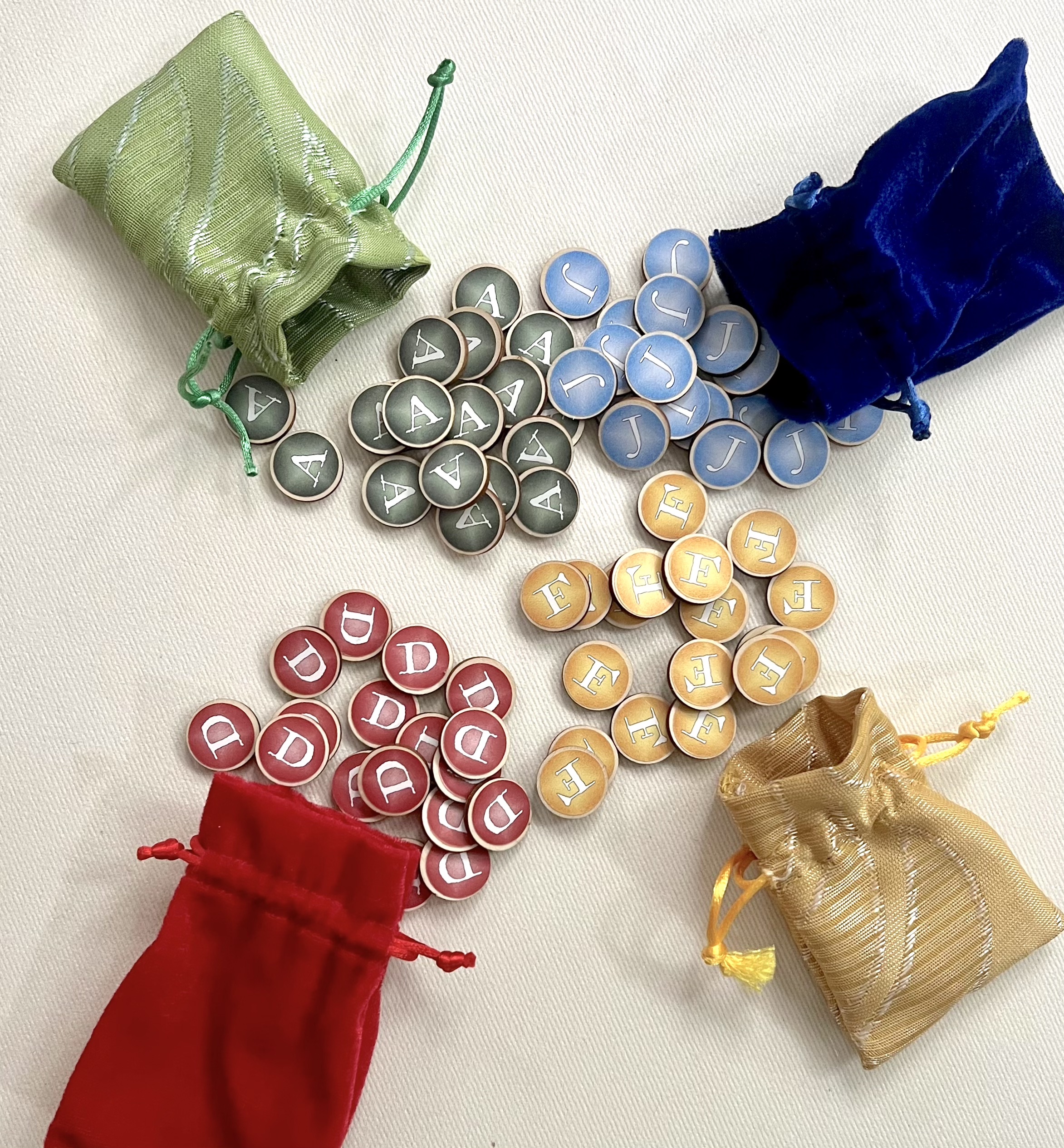
Now, in order to conquer cities, as mentioned earlier players can take an open one when landing on it with the roll of the dice by using the “gain an army” card or they can take them in a much easier way using the “besiege a city” card which allows them to jump to the nearest city and take it, while the “sack a city” is more powerful as it allows a player to take any owned city.

Conquering Constantinople meanwhile is a bit more difficult as it is the imperial capital, thus in order to take it, a player needs 2 “gain an army” cards or rather they can take it by travelling all the way to the “gain a navy” anchors, and in a rare occasion they can take it using the “sack a city” card. As mentioned earlier, using a single “gain an army” card or the “besiege a city” card does not work when it comes to capturing the capital. As cities can be taken in the game, players can also lose them despite it being almost impossible to take a conquered city. Players thus can lose a city either when it is stolen from them by another player using the rare “sack a city” card, when another player steals it from them by landing on the “gain a navy”, or when a player draws the “rebellion” card. Owning Constantinople meanwhile has a lot of perks especially since it involves a challenge to conquer it, thus the major perk about owning Constantinople is that the player who owns it is immune to the rebellion card, meaning he or she cannot lose any city they own. However, a player who owns Constantinople can still lose it when another player takes it by using the “gain a navy” or the rare “sack a city” card. Originally, when the game was first conceptualized in 2019, Constantinople had no special perks but was rather just another city like the others that players can easily take the same way the other cities can. However, in the development phase of the game, in order to give more value to Constantinople as the capital, these new rules were added wherein it would be more difficult to take it. Additionally, Constantinople is equivalent to two points, so if a player owns it, it is worth two cities. Meanwhile, if a player so happens to land on a city whether owned or unowned by the roll of the dice while not possessing any “gain an army” card, then he or she is simply just visiting. The same also applies for Ragusa as when a player so happens to land on it with the roll of the dice and does not have the “plague” card, then again, he or she is just visiting. Other than that, if a player happens to land on the same tile another player is already on, then nothing happens except that two characters are simply sharing the same tile.
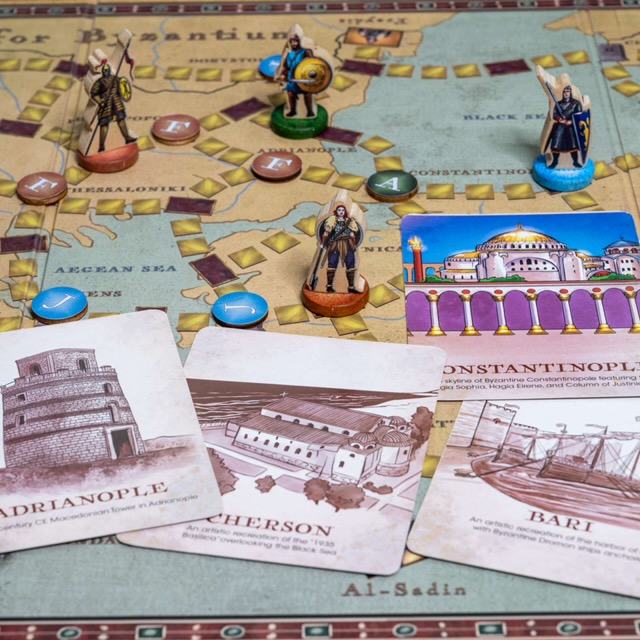
Originally, when being conceptualized, the objective of “Battle for Byzantium” was to take all cities on the map and the game ends when one player owns all cities, meaning players could use the “gain an army” or “besiege a city” card to take any city on the map whether owned or not. However, this kind of objective would make the game too long to play, thus in the development phase the rules were changed while new cities were added as well from 10 in the first version to 18 in the final one. In order to simplify the game, the rules were made that players cannot take owned cities and thus the one who wins would own the most number of cities and not necessarily all cities on the map. Although to add some more excitement to the game wherein players can still happen to take owned cities though rarely, the “gain a navy” and “sack a city” card were added. Now, when it comes to finishing the game, it ends when all 18 cities are conquered and the one who has the most wins. However, in the rare case wherein there is a tie among players, then the one who owns Constantinople wins. Constantinople too is equivalent to two points so at the end the player who owns it has an additional point. Meanwhile, if the full version of the game takes a very long time to play, then players can go for the option of playing the shorter version of the game and this ends when all the action cards have been used, and thus the one with the most number of cities wins the game. Although if players choose to play the full version and the action cards run out at the middle of the game, then the action cards surrendered to the discard pile must be reshuffled and then reused.

Conclusion and Game Reception

The entire creation process of the board game from its conceptualization to the development phase and finally to its completion and distribution phase was a total of 4 years! At least at this point I’ve come to realize that all the hard work of the past 4 years has finally paid off now that the game is already out there and for sale. What I did realize now from the creation process of the game is that a project at this scale with many components, rules and mechanics, and elements really takes a lot of time, brainstorming, debating, and alterations especially if the finished product is to be an impressive one. True enough this game goes all the way back 4 years ago to 2019 wherein the idea and the first prototype of it came about, however for a long time the entire project was forgotten until I decided to bring it back in 2021 when thinking of creating a business out of my own passion for Byzantine history. However, it was only in mid 2022 when the execution of this project took place which included the illustration phase first by Chrysa for the characters, action cards, city cards, and box cover and following that the map by Alessia, the character stories by Franco Gallardo (follow him on Instagram @franco.gallardo96) and consultations on designs by Nilay, and the artworks of both artists assembled together by the game’s layout artist Arjun Altomonte (follow him on Instagram @ctrl_arj_del) which thus put the game together. Additionally, the final phase which included proofing and printing as well as distribution took even longer that the entire process was completed in June of 2023, thus whole process was really a total of 4 years! In the meantime, a lot of brainstorming and debating took place regarding both the artworks for the game, the mechanics, and elements that goes in it, but at the end I would say that it all paid off especially since the final result was both a fully functioning board game in terms of mechanics and an artistic masterpiece.

So far, the board game has received positive feedback from viewers and buyers who are both entertained by the gameplay especially since it is a game of chance wherein fortunes can easily turn while others admire it for the art done by both Chrysa and Alessia. Most people who have played the game so far found it excitable especially due to its unpredictable nature while some found it simple to play and understand that they did not need a manual, and this is how I intended the game to be in the first place, though some on the other hand found the game’s gameplay too long- as it is a 1 to 2-hour game- and some found it too much based on luck. Meanwhile, on the negative side, some mentioned in the comments on my social media accounts complaining that its title is not accurate as the Byzantines in their time never referred to themselves as such but rather as “Romans” while the whole point of having a female Varangian character being Freydis was also questioned. On the other hand, my intention true enough for the game was to give people a fun, exciting, and easy to understand board game that could at the same time also educate them about history, more specifically on the lesser-known history of the Byzantine Empire which often is not represented in entertaining media such as board games. Through this board game, I hope to make the fascinating yet lesser-known history of Byzantium accessible to more people around the world especially to everyday people rather than keeping the subject something only limited to scholars and historians. So far, I have been achieving this objective through the game especially since the buyers so far were not academics but simply gaming, art, and history enthusiasts while on the other hand I’ve also had a number of features in the media already. Of course, this is not it yet as I have more hopes and dreams for the game but I will have to save that for another time. And now, this is about it for this article on the mechanics and elements for the “Battle for Byzantium” board game, goodbye and thanks for reading!
